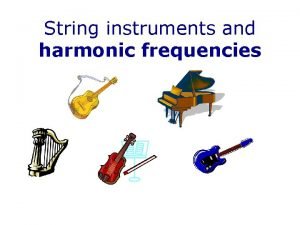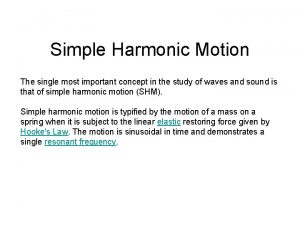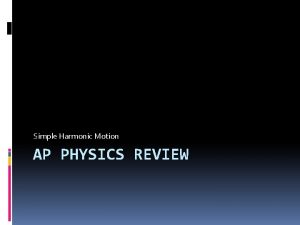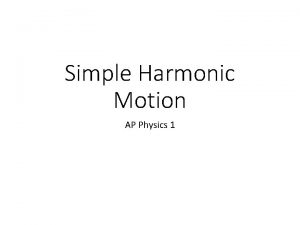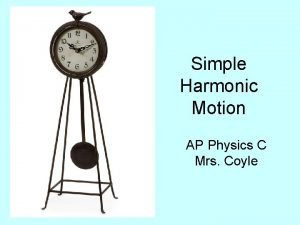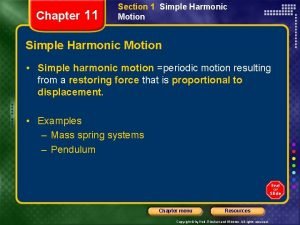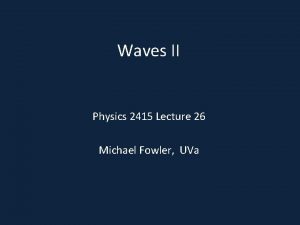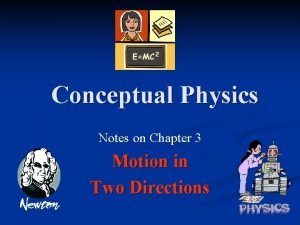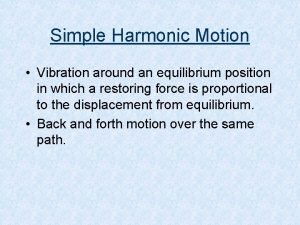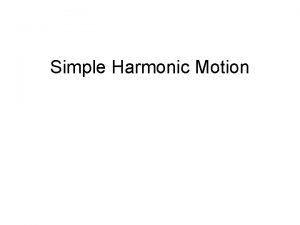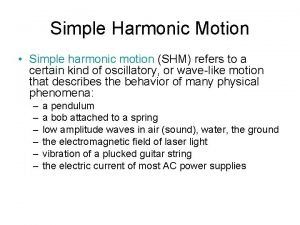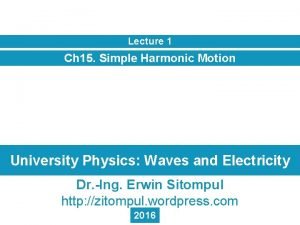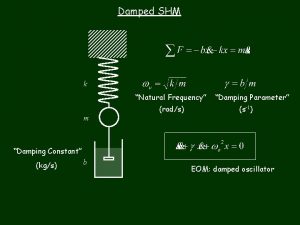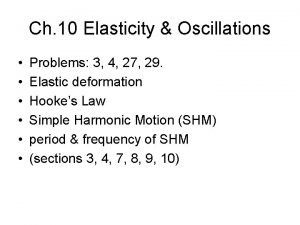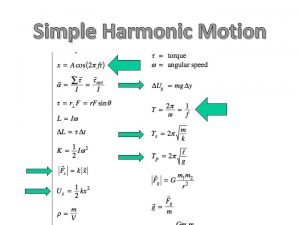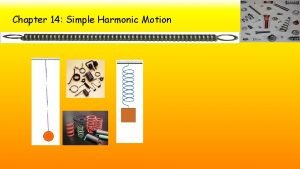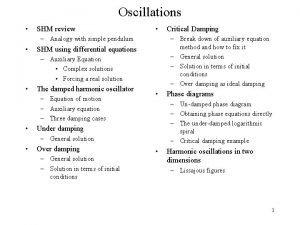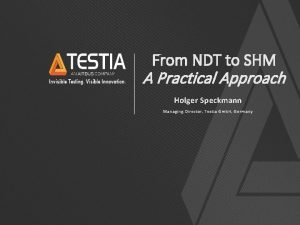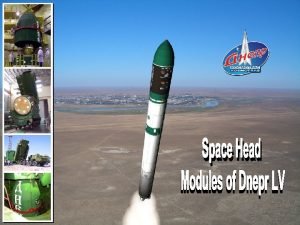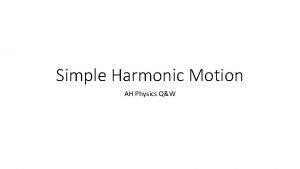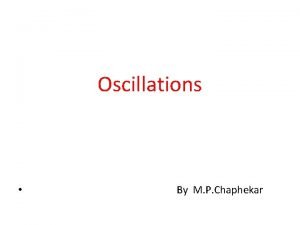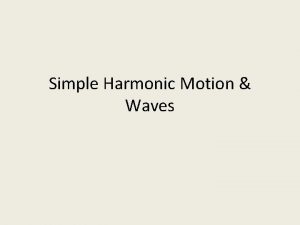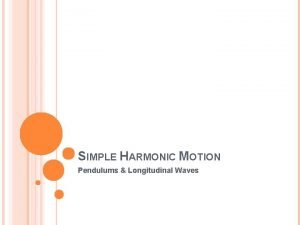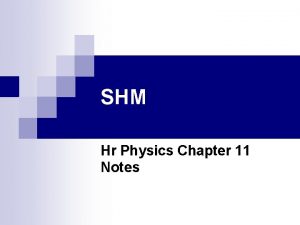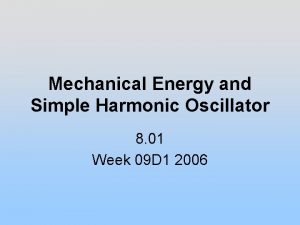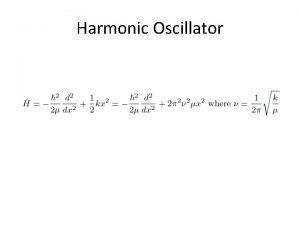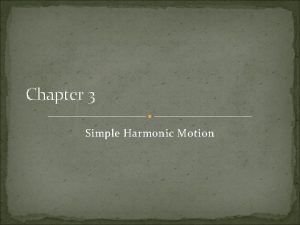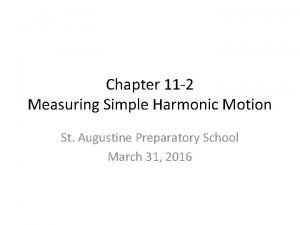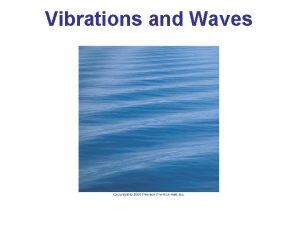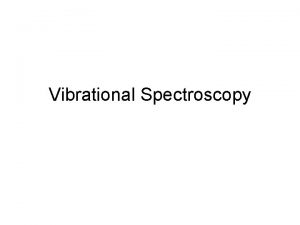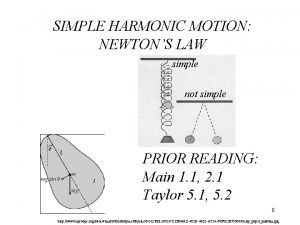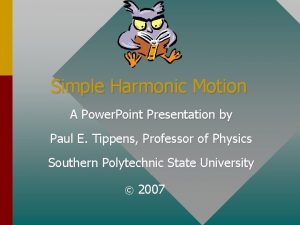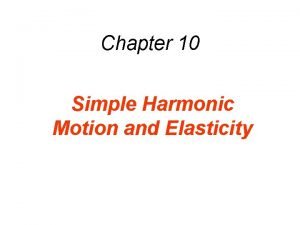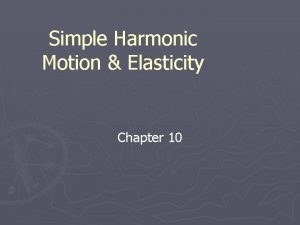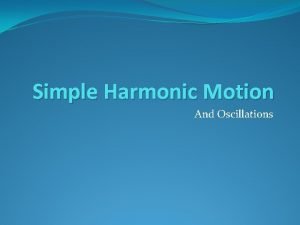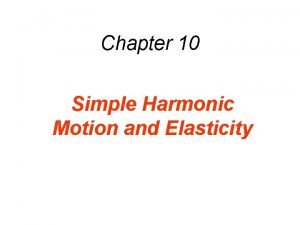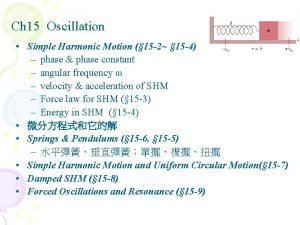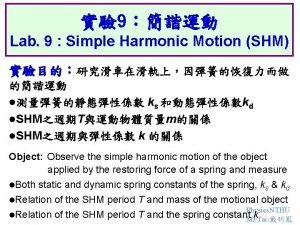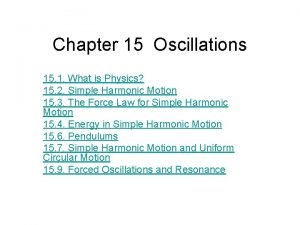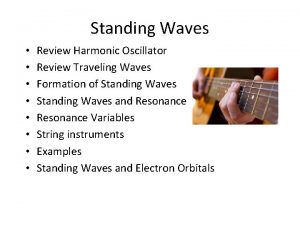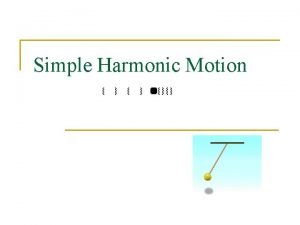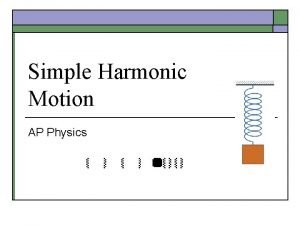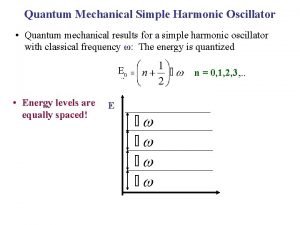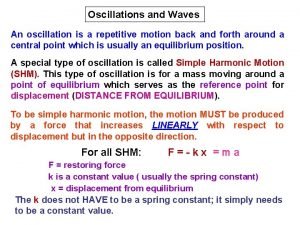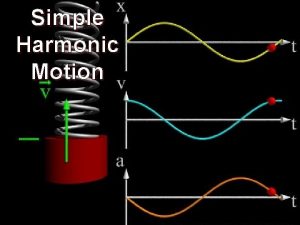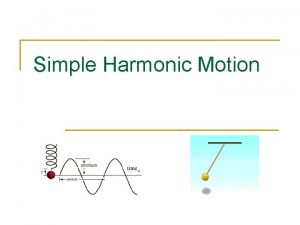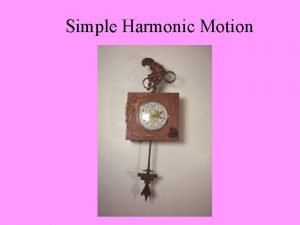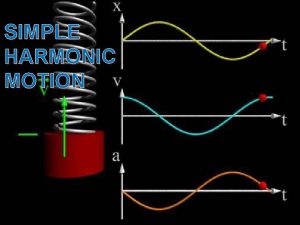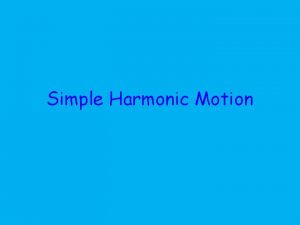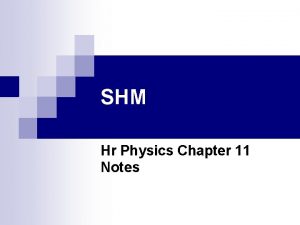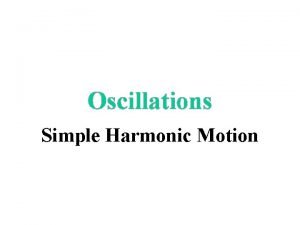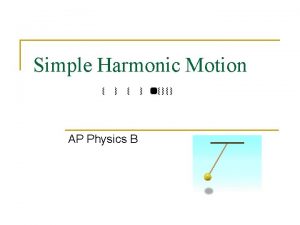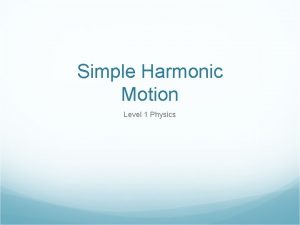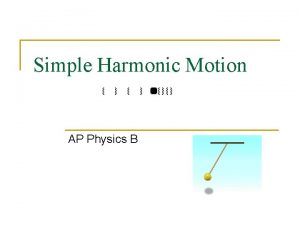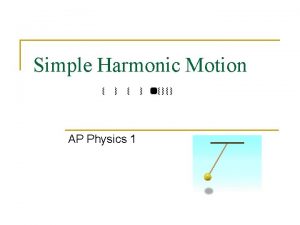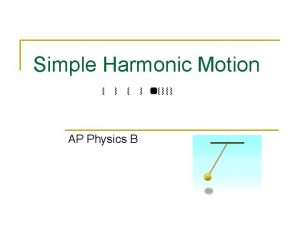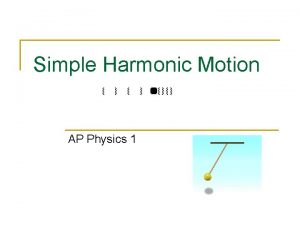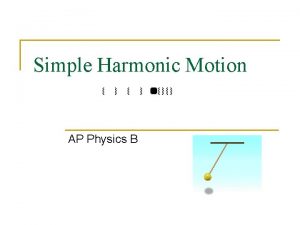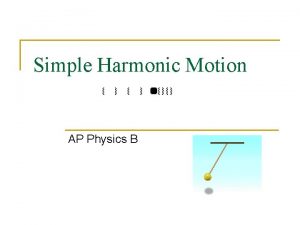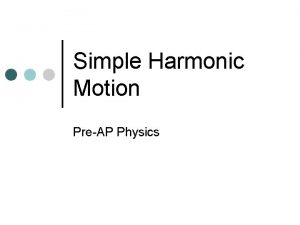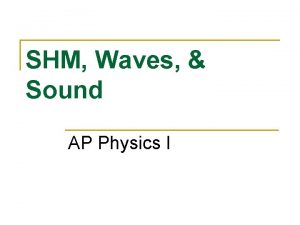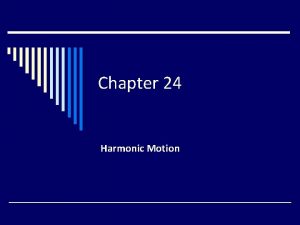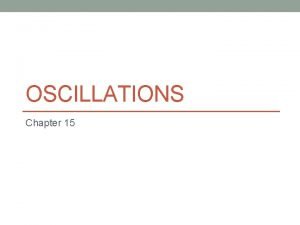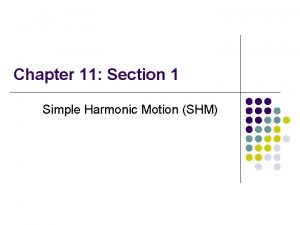SHM Hr Physics Chapter 11 Notes Simple Harmonic























































- Slides: 55

SHM Hr Physics Chapter 11 Notes

Simple Harmonic Motion Objectives Identify the conditions of simple harmonic motion. n Explain how force, velocity, and acceleration change as an object vibrates with simple harmonic motion. n Calculate the spring force using Hooke’s law. n

Simple Harmonic Motion n Simple Harmonic Motion gives a regular repeating action. ¨ Any periodic motion that is the result of a restoring force that is proportional to displacement. n Springs, Masses, Pendula, and Bells, exhibit a periodic motion, therefore, SHM.

Hooke's Law n Hooke's Law says that the restoring force due to a spring is proportional to the length that the spring is stretched, and acts in the opposite direction. If we imagine that there are no other forces, and let x represent the distance the spring is stretched at time t then the restoring force might be represented as -kx where k is the spring constant and k > 0.



Hooke’s Law Demonstration


Hooke’s Law Concept Check n If a mass of 0. 55 kg attached to a vertical spring stretches the spring 36 cm from its original equilibrium position, what is the spring constant?

Hooke’s Law Concept Check n 15 N/m

Hooke’s Law Concept Check n A load of 45 N attached to a spring is hanging vertically stretches the spring 0. 14 m. What is the spring constant?

Hooke’s Law Concept Check n 3. 2 x 102 N/m

Hooke’s Law Concept Check n A slingshot consists of a light leather cup attached between two rubber bands. If it takes a force of 32 N to stretch the bands 1. 2 cm, what is the equivalent spring constant of the two rubber bands?

Hooke’s Law Concept Check n 2. 7 x 103 N/m

Hooke’s Law Concept Check n How much force is required to pull a spring 3. 0 cm from its equilibrium position if the spring constant is 2. 7 x 103 N/m?

Hooke’s Law Concept Check n 81 N

The Simple Pendulum The restoring force is a component of the bob’s weight, so F= Fg sin θ n For small angles (less than 1 ), the motion of a pendulum approximates simple harmonic motion. n

Measuring Simple Harmonic Motion Objectives Identify the amplitude of vibration n Recognize the relationship between period and frequency n Calculate the period and frequency of an object vibrating with simple harmonic motion n



Galileo’s Laws of the Pendulum Concept Check n You need to know the height of a tower, but darkness obscures the ceiling. You note that a pendulum extending from the ceiling almost touches the floor and has a period of 24 s. How tall is the tower?

Concept Check n 1. 4 x 102 m

Concept Check n You are designing a pendulum clock to have a period of 1. 0 s. How long should the pendulum be?

Concept Check n 25 cm

Concept Check n A trapeze artist swings in simple harmonic motion with a period of 3. 8 s. Calculate the length of the cable supporting the trapeze.

Concept Check n 3. 6 m

Concept Check n Calculate the period and frequency of a 3. 500 m long pendulum at the following locations: ¨ The North Pole, where g=9. 832 m/s 2 ¨ Chicago, where g = 9. 802 m/s 2 ¨ Jakarta, Indonesia, where g=9. 782 m/s 2

Concept Check 3. 749 s; 0. 2667 Hz n 3. 754 s; 0. 2664 Hz n 3. 758 s; 0. 2661 Hz n

Simple Harmonic Motion of a Mass. Spring System n The period of a mass-spring system depends on the mass and the spring constant. n T= 2 (m/k)

Simple Harmonic Motion of a Mass. Spring System Concept Check n A mass of 0. 30 kg is attached to a spring and is set into vibration with a period of 0. 24 s. What is the spring constant of the spring?

Simple Harmonic Motion of a Mass. Spring System Concept Check n 2. 1 x 102 N/m

Simple Harmonic Motion of a Mass. Spring System Concept Check n A spring of spring constant 30. 0 N/m is attached to different masses, and the system is set in motion. Find the period and frequency of vibration for masses of the following magnitudes: ¨ 2. 3 kg ¨ 15 g ¨ 1. 9 kg

Simple Harmonic Motion, cont’d ¨ 1. 7 s, 0. 59 Hz ¨ 0. 14 s, 7. 1 Hz ¨ 1. 6 s, 0. 69 Hz

Properties of Waves Objectives n n n Distinguish local particle vibrations from overall wave motion. Differentiate between pulse waves and periodic waves. Interpret waveforms of transverse and longitudinal waves. Apply the relationship among wave speed, frequency, and wavelength to solve problems. Relate amplitude and energy.


Wave Motion A wave is the motion of a disturbance. n The medium is the physical environment through which a wave travels. n Waves that require a medium are called mechanical waves. n




Wave Speed Concept Check n A piano emits frequencies that range from a low of about 28 Hz to a high of about 4200 Hz. Find the range of wavelengths in air attained by this instrument when the speed of sound in air is 340 m/s.

Wave speed, cont’d n 0. 081 m to 12 m

Wave speed concept check n The red light emitted by a He-Ne laser has a wavelength of 633 nm in air and travels at 3. 00 x 108 m/s. Find the frequency of the laser light.

Wave speed, cont’d n 4. 74 x 1014 Hz

Wave Interactions Objectives Apply the superposition principle n Differentiate between constructive and destructive interference. n Predict when a reflected wave will be inverted. n Predict whether specific traveling waves will produce a standing wave. n Identify nodes and antinodes of a standing wave. n

Interference n n Constructive interference occurs when the waves displacements occur in the same direction so the superposition of the two waves results in the addition of the amplitudes. Destructive interference occurs when the waves displacements occur in opposite directions so the superposition of the two waves results in the addition of the two amplitudes.


Constructive and Destructive Interference








 First harmonic and second harmonic
First harmonic and second harmonic Simple harmonic motion energy equation
Simple harmonic motion energy equation Simple harmonic motion formula
Simple harmonic motion formula Ap physics 1 shm review
Ap physics 1 shm review Ap physics 1 simple harmonic motion
Ap physics 1 simple harmonic motion Shm equation of motion
Shm equation of motion Harmonic equation physics
Harmonic equation physics Simple harmonic motion chapter 11
Simple harmonic motion chapter 11 Harmonic waves
Harmonic waves Physics 101 lecture notes pdf
Physics 101 lecture notes pdf Conceptual physics notes
Conceptual physics notes Equilibrium position of a wave
Equilibrium position of a wave Spring constant simple harmonic motion
Spring constant simple harmonic motion Frequency of shm
Frequency of shm Slidetodoc
Slidetodoc Graphical representation of shm
Graphical representation of shm Shm k
Shm k Frequency of shm
Frequency of shm Shm reference circle
Shm reference circle How is linear frequency related to angular frequency?
How is linear frequency related to angular frequency? The cone of a loudspeaker vibrates in shm
The cone of a loudspeaker vibrates in shm Lissajous figures in shm
Lissajous figures in shm Holger speckmann
Holger speckmann Shm
Shm Shm
Shm Harmoninic ah
Harmoninic ah Angular oscillation
Angular oscillation Simple harmonic motion vocabulary
Simple harmonic motion vocabulary What unit is period measured in
What unit is period measured in A trapeze artist swings in simple harmonic motion
A trapeze artist swings in simple harmonic motion Simple harmonic motion formula
Simple harmonic motion formula Selection rule for harmonic oscillator
Selection rule for harmonic oscillator Euler cromer method pendulum
Euler cromer method pendulum Measuring simple harmonic motion
Measuring simple harmonic motion Simple harmonic motion formula
Simple harmonic motion formula Selection rule for anharmonic oscillator
Selection rule for anharmonic oscillator Simple harmonic motion formula
Simple harmonic motion formula Simple harmonic motion presentation
Simple harmonic motion presentation Simple harmonic motion and elasticity
Simple harmonic motion and elasticity Simple harmonic motion and elasticity
Simple harmonic motion and elasticity Kinematics of simple harmonic motion
Kinematics of simple harmonic motion Simple harmonic motion and elasticity
Simple harmonic motion and elasticity Simple harmonic oscillator amplitude
Simple harmonic oscillator amplitude 戴明鳳
戴明鳳 Acceleration in simple harmonic motion
Acceleration in simple harmonic motion Simple harmonic oscillator
Simple harmonic oscillator What is simple harmonic motion
What is simple harmonic motion Simple definition of motion
Simple definition of motion Simple harmonic motion definition
Simple harmonic motion definition Simple harmonic motion
Simple harmonic motion Simple harmonic motion
Simple harmonic motion Simple harmonic motion
Simple harmonic motion Simple harmonic motion lecture
Simple harmonic motion lecture Cube wisc
Cube wisc Wave motion physics notes pdf
Wave motion physics notes pdf Classical mechanics
Classical mechanics
